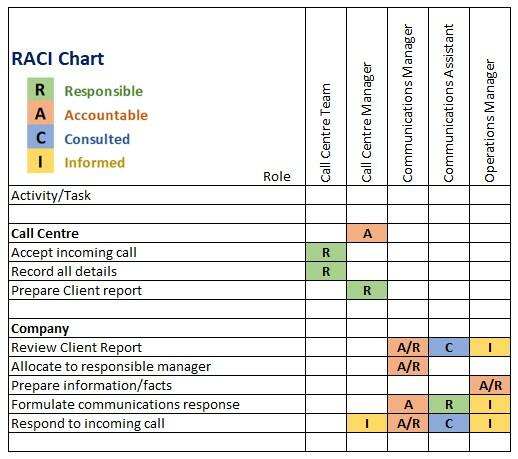
Creating a RACI: It’s well worth the effort

Andrew Ward CQP MCQI outlines the value of a RACI matrix when assigning roles and duties in any task.
Written procedures can sometimes leave some doubt as to who is responsible for what actions. A simple way to clarify this is to include a RACI chart in the procedure as the means to clarify to all who is involved, and the requirements imposed upon them for the actions.
RACI is the abbreviation for ‘responsible, accountable, consulted and informed’. It sets out in a matrix format those who have duties in any process.
There are two parts to this matrix: roles and activities/tasks.

Roles always refer to a post, not a named individual, to avoid the need for change if people move on. In the RACI matrix, the role can either be a specific post or a collective post. In the example of a fictional business complaints process where an initial complaint goes to a call centre, note that anyone in the call centre team who could take the call is recorded as a collective role, while the call centre manager is a specific role. Determining the split is important in how the RACI is later used.
Using the RACI matrix
The activities/tasks themselves are the general stages of the process. In the example, the actions are split between the call centre and the company. This split could equally be between different departments in a business. Not all processes lend themselves to this type of breakdown, so it is used only when possible and to give clarity. Key, however, is not to put every stage of a process into the activity/task list but to keep it general. The RACI matrix is not a replacement or duplication of the details in the process; the process needs to be used to determine the activity/task listing.
The effort needed to produce a RACI is far outweighed by the benefits of having it to check and the clarity it gives to those involved.
Having decided on the roles involved and the activity/task breakdown, it is then about ensuring that the RACI terms are correctly allocated.
A practical way of achieving this is to go through the process from the beginning and populate the RACI for each activity/task. If it is not possible to complete the RACI, that often indicates the process needs clarification and further details adding.
Critical for each activity/task is showing where ‘accountable’ and ‘responsible’ lie. Using our example, the call centre manager is made accountable for all the activities in that group – on the chart, the ‘A’ being shown in the group activity/task. The ‘accountable’ varies across the company, and so is included on each line.
Some tasks have more than one RACI term associated with each role. In the example, a number are both ‘responsible’ and ‘accountable’, indicated by A/R on the chart.
Advantages of the process
Completing a RACI can be time consuming, particularly for complex processes. However, there are advantages in undertaking their completion and incorporating them into any set process. These include:
- Compilation offers a systematic review of the process. For this reason, it is suggested that the RACI is not produced until the process has been set out and deemed complete. The RACI compilation can be used as the check to ensure sufficient information is included in the process, avoiding misunderstanding in its implementation.
- It provides clarity, by eliminating any misunderstanding to all involved in the process as to who does what.
- It's easier to brief a new starter to a role. The RACI makes it simple for the person to see clearly the parts in which they are involved – important if the flowchart for the process is not in ‘swimming lanes’ of roles.
- It clarifies for any auditor of a process those staff members who need to be interviewed and what their involvement is in the process.
In practice, the effort needed to produce a RACI is far outweighed by the benefits of having it to check and the clarity it gives to those involved. It is flexible in how it can be formatted and presented (carry out an internet image search of RACI charts for other examples). Don’t be put off when struggling to compile the first one, they become easier the more you do them – honest!
The Quality Tool Selector
Discover a compendium created specifically to help you choose the right quality tool for the right task.